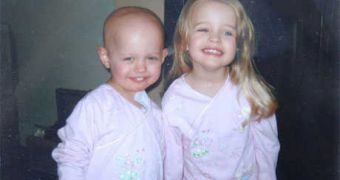Leukemia is one of the main killer cancers in children. In the last 50 years, medical advance has boosted survival rate from 0 % to 90 %, but the aggressive chemotherapy comes with a high price caused by the secondary effects. Still, hope comes with a new research published in the journal Science and made on four-year-old twin girls from Bromley (Kent): researchers have detected rogue cells that trigger childhood leukemia, and this could translate in the near future to specific and less intensive treatments for leukemic children.
Both girls have the "pre-leukemic" cells in their bone marrow, but by now, only one has leukemia, as a second mutation is required to trigger the disease. Leukemia installs when bone marrow is replaced by white blood cells, and the body can no longer produce normal blood cells.
Olivia Murphy had acute lymphoblastic leukemia when only two-years old, while her sister, Isabella, is healthy. The research team discovered that the preleukemic cells were caused by a mutated gene, caused by a wrong rejoining of DNA, and the mutation could have been passed from one twin to the other in the womb through the blood. Still, a second mutation is required for triggering the cancer. Infection is linked to this, and that's why Olivia got cancer and Isabella didn't.
Isabella is rigorously monitored for signs of leukemia, but during adolescence the risks become slim to none.
The preleukemia cells could be found in 1% of the newborn, but only 1% of the children will experience leukemia. The main concern is that current treatments are far too aggressive and relapse is not excluded. Olivia has already lost the sight in one eye, as she could not fight an eye infection due to the chemotherapy. By targeting specifically the preleukemic cells, the treatments would be less aggressive and relapse would be excluded.
"These are the cells which drive and maintain the disease. Now we know about the cell, hopefully we can find an Achilles heel we can target," lead researcher Professor Tariq Enver, from the Medical Research Council Molecular Hematology Unit in Oxford, said.
"I suspect that the stem cells can escape conventional chemotherapy and cause relapse. The study in the twins had been unique. There is an element of chance, we still have to work out why it happens in one child and not the other. We're pretty certain it's triggered by common childhood infection," co-author Professor Mel Greaves, from the Institute of Cancer Research added.
"A significant number of children are now being over-treated but we don't know which children. In the future, children could be tested to see if the stem cells had been killed off after the first few weeks of chemotherapy with some being able to stop treatment earlier, sparing them harmful side-effects," Dr. Phil Ancliff, consultant in pediatric hematology at Great Ormond Street Hospital, explained.
"This important paper shows how leukemia develops, and how it can persist even after therapy. By identifying the cells involved, it raises the hope that we will be able to identify children at risk of relapse, and develop new, targeted drugs to treat the disease," Vaskar Saha, professor of pediatric oncology at Cancer Research UK, told BBC News.

 14 DAY TRIAL //
14 DAY TRIAL //